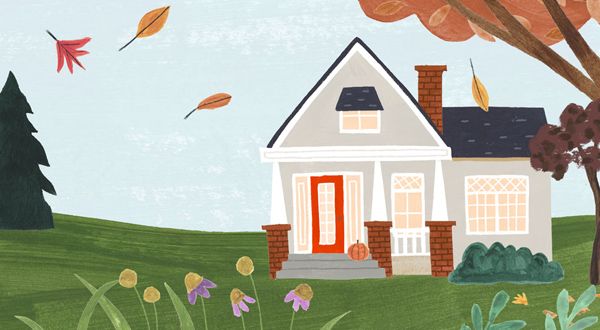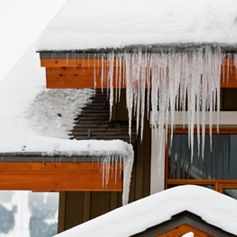"Spring is the time to check homes in the Northwest top to bottom for evidence of leaks and to protect against rain that will come later in the year."
— Frank Lesh, American Society of Home Inspectors spokesperson
Nicholas Bond is the state climatologist for Washington, holds a doctorate in atmospheric sciences and has served as an expert witness in legal cases involving floods, landslides and water damage in the Pacific Northwest. But when he found three inches of water in his own basement during heavy rains last year, he was taken entirely by surprise.
"I didn't see that one coming," says Bond, whose Seattle-area home was built in the 1940s and has a sewage system connected to the storm-water system, as many older homes do. "I could see it was coming out of a drain in the basement." Roots had crept into the pipes, causing a blockage that flooded the basement.
The cost of repairs: $12,000.
There is a magic to the Northwest that lies in the vast natural resources that attract people who appreciate the great outdoors — perfect summers in Oregon, mild winters along the Pacific coast and cozy ones in Wyoming, quintessential fall weather in Idaho. But even weather experts and lifelong residents can overlook home maintenance in a region that spans a range of climates.
Here, a season-by-season look at the woes homeowners face and maintenance suggestions for girding homes against the elements.
SPRING

Jennifer Yarbrough was sitting down to dinner in her Spokane, Washington, home when her living room ceiling split open and unleashed 15 gallons of water one spring evening. Five years earlier when she purchased the home, she was told that the roof was brand new. "It looked like a beautiful house," says Yarbrough. She credits that roof for her current career as a home inspector.
Yarbrough believes roofers had left space between the shingles in a cost-saving move. Water leaked in, but the only hint of a problem was the slightest discoloration on the living room ceiling. "You'd see it and think it was dust," she says.
Now, every spring, as winter storms relent, she inspects her current home’s roof for damage. In the 260-plus homes she inspects annually, she always checks roofs — even “new” ones.
After months of heavy wind, rain, snow and freezing temperatures, spring is the time to check homes in the Northwest top to bottom for evidence of leaks and to protect against rain that will come later in the year, says Frank Lesh, a 30-year veteran of commercial and residential home inspection and an American Society of Home Inspectors spokesperson. Thawing pipes can show exactly where they have been compromised, he says, and fixing a leak in the dead of winter can be more work — and more costly.
Near the Pacific Northwest coast, spring is also the best time to open closets and check for mustiness and moisture, Lesh says. A wet jacket stuffed into a hall closet can lead to mildew if it's humid enough. And in places where humidity consistently tops 60 percent, like Seattle and Portland, there’s a potential for moisture to condense and help molds, including musty-smelling mildew and the asthma- and sneeze-inducing black mold, to grow on damp surfaces.
Spring Home-Maintenance Tips
Open attic and crawl space vents.
Allow air to circulate in the home, says Robert Thomas, a real estate agent and plumbing company owner for 21 years in Coeur d'Alene, Idaho. No vents? Consider having them installed; a lack of airflow can encourage mildew in the attic or cause roof damage from summer heat. And, Thomas adds: "Make sure exhaust fans in bathrooms are open to the outside and are not covered with insulation." Otherwise, moisture might blow into the attic.
Assess exterior wood for winter damage.
Look for exposed nails and wood. Re-stain decks and repaint siding and doors and windows as needed. "I do a coating of my front and rear porches every three or four years," says Hugh Kelso, a Puget Sound–area home inspector who specializes in historic and high-end homes.
Inspect for animal invasions.
Lesh also suggests repairing screens over vents leading to crawl spaces and attics and check the exterior for holes where wild animals might squeeze through. Lesh once found a hole in a chimney made by a nesting raccoon. "Water was just pouring in," he says; it’s the kind of leak that seeps downward and could end up rotting structural wood.
Check the H V A C system.
Make sure air-conditioning coils and filters are clean. Replacing a filter can improve efficiency and lower heating or cooling costs by 5 to 15 percent, according to the U.S. Department of Energy.
SUMMER

Summer is the time to sharpen the clippers, call the arborist and make sure trees and shrubs are ready for possible wildfires and winds come late summer and fall.
If fire breaks out nearby, trees and shrubs close to the house can catch windblown embers and put the home at risk. Trees next to houses can act as onramps for pests and critters, too, says Lesh, and can wear away shingles and siding.
Diseased trees and limbs are vulnerable to falling when strong winds hit — and the Pacific Coast has known storms with hurricane-force winds, up to 120 miles an hour.
Karin Bumbaco, assistant state climatologist for Washington, thought her Seattle home was safe from falling tree limbs because the strongest winds typically blow in from the south or southwest, and her property was free of trees vulnerable to strong southerly winds. “Trees grow to protect themselves from that wind,” says Bumbaco.
Then a winter storm hit from the north and knocked an otherwise healthy 30-foot-tall tree down. It fell across three property lines, landing on Bumbaco's fence.
Bumbaco now has her eye on a tall fir tree in her neighbors' yard and is talking to them about potential problems. "Knowing we can have these strong winds from the north makes me realize we are potentially vulnerable," she says.
Summer Home-Maintenance Tips
Assess the property’s grade.
Daniel Force, a home inspector in Eugene, Oregon, notes that the ground surrounding a home should slope down, away from the house, to direct rainwater from downspouts away from the foundation, where pooling water can cause costly cracks, leaks, and settling. Adding extensions to downspouts can help move the water away, says Force.
Clean the exterior
Check for peeling paint and cracks — anything wider than a quarter of an inch could be a sign of a foundation issue. Consider having it inspected by an engineer, says Force. "I've seen a house basically split in half from a crack that was an inch and a half wide." Smaller cracks in trim joints can be sealed or siding imperfections repaired with an oil-based outdoor caulk.
Start the backup generator.
In areas where the power often goes out during storms, inspect and start the backup generator to get a refresher on how it works. "At two in the morning with the power out, trying to read the manual is not much fun," says Kelso, the Puget Sound home inspector.
FALL

Rain pours across the Northwest in the fall — something climatologist Bond knows from professional experience, but the extent of problems it can cause caught him by surprise as a homeowner. Before the first storm hit in fall 2018, there was no sign he had a plumbing issue so severe that he’d wind up with three inches of sewage and storm water in his basement, including one carpeted room.
"We’d had heavy rains before and no problem," says Bond. But as he learned from the substantial repair bill, which included tearing up and replacing a concrete patio, "roots had grown into the pipes enough that the system was overwhelmed."
Force suggests sewer camera inspections in homes older than 15 years. Roots that are starting to infiltrate pipes can be cut out before they jam pipes — and culprit trees or shrubbery can be removed.
Fall Home-Maintenance Tips
Insulate pipes.
Wrapping pipes in insulating material, and adding insulation to crawl spaces, unfinished basements or attics can help prevent pipes from freezing and bursting in winter.
Check and clean chimneys.
Cracks and soot can be a fire hazard come fireplace season.
Store garden hoses.
Hoses connected to spigots attached to the house can accumulate water, which can freeze and crack pipes and flood your house, says Thomas. He suggests insulating the spigot, unless it's a frost-free hose bib.
Clear debris off the roof — twice.
Force recommends removing leaves and other debris in early fall and again after trees have dropped the last of their leaves. In wet weather, this organic material can act like a sponge, collecting water and weight that can cause damage.
Store or secure yard “missiles.”
In a wind storm, lawn furniture, grills, awnings, toys and garden tools can get launched into windows (including the neighbors’) and cause other damage, says climatologist Wolf Read, a specialist in the Pacific Northwest.
Check the H V A C system (again).
Before firing up the heat, call in an H V A C specialist to calibrate the thermostat, tighten electrical connections and lubricate parts to prevent wear and tear. Filters should be checked every month, according to U.S. government energy guidelines, and changed when dust and debris builds up; how often could vary widely according to the thickness of the filter, how often the heat is run and factors like the presence of pets or smokers.
Clean the sump pump and pit.
Follow the manufacturer’s maintenance and service schedule for cleaning the pump and pit. Even in Wyoming, where the climate is thought of as dry, home inspector Daniel Gillihan says water under homes can be an issue. In homes with basements, sump pumps can remove water from leaks during wet weather and help prevent damage to the foundation. "People don't understand that when you're living near a stream, water could be two feet below your foundation," he says.
WINTER

Idaho plumbing pro Thomas recalls one particularly gnarly winter damage war story caused by the most mundane (and mostly preventable) problem: Attic vents left open during a frigid spell allowed winter winds to travel down pipes that connected a home’s drainpipe to the sewer.
“We had to rip out an entire copper plumbing system, and you can't fix copper; you have to cut it out because it will just split,” says Thomas. “The P-traps were all frozen; they started to freeze down the line of the pipes."
His cost to repair: $7,000.
Ice dams are another story. Snow in the Northwest is notoriously heavy because of its high water content and can quickly freeze into ridges of ice on roofs, potentially blocking gutters, damaging shingles and causing water to seep into a home. Even on the milder Pacific side, ice dams and snow melt can create a range of expensive problems, from frozen pipes to major moisture and water damage.
Help to prevent ice dams: Make sure the roof — and any snow on it — stays cold. There should be enough insulation between the top floor’s ceiling (where warmth from a cozy home rises) and the attic to keep the heat from melting snow on the roof. Caulk and block any tiny cracks that let heated indoor air rise to warm the attic and roof. Add vents to the attic, if needed, to let cold outside air move under the roof.
Removing snow, to the extent that it's safe to do it, will also help keep ice from forming, says Bond.
Winter Home-Maintenance Tips
Blow water out of outdoor sprinkler lines
In areas like Billings, Montana, the ground can freeze 44 inches below the surface, says Montana home inspector Rick Shaver, who had to replace his own irrigation system after it froze, cracked and started leaking into his basement.
Check weatherproofing around doors and windows.
Air leaks can cost precious heat — and money. They make themselves obvious on cold, windy days — and are easily blocked with weather stripping.
Change the refrigerator filter.
Depending on use, this could be done at least once a year to keep water and ice tasting clean.
Help keep pipes safe.
Setting the thermostat at 45 to 55 degrees before leaving for a trip, says Thomas. "I keep the water pipe cabinets open so they get the direct heat from the house," he adds.
Home maintenance can be a dirty, seemingly thankless job, but getting to know a home inside and out — even the dark, dirty places — can pay off.
"I know people don't like crawl spaces or attics, but they need to know what it looks like so they can identify a change," says Jennifer Yarbrough.
Playing detective to find the source of a leak or looking into a discoloration on a ceiling could save money and time in the future. For Yarbrough, it also led to a new career path.
"That little moisture intrusion was life-altering."

Your roof can’t wear a puffy
coat in cold weather.
Find out how you can keep it cozy.
Get a quote
Includes personal service from a Farmers agent.
Written by
The information contained in this page is provided for general informational purposes only. The information is provided by Farmers® and while we endeavor to keep the information up to date and correct, we make no representations or warranties of any kind, express or implied, about the completeness, accuracy, reliability, suitability or availability with respect to this article or the information, products, services or related graphics, if any, contained in this article for any purpose. The information is not meant as professional or expert advice, and any reliance you place on such information is therefore strictly at your own risk.



